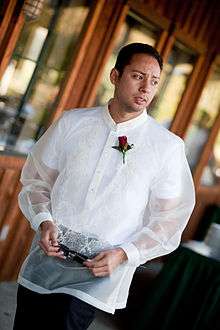Mexican settlement in the Philippines
Mexican settlement in the Philippines comprises a multilingual Filipino ethnic group composed of Philippine citizens with Mexican ancestry.[1] The immigration of Mexicans to the Philippines dates back to the Spanish period. Migration from Mexico has been important since the Spanish period and when the Philippines was trading with this country during the Viceroyalty of New Spain, Mexican mestizos mixed with the inhabitants of the islands, similar to the amount of Spain and the United States, numbering up many names of Spanish origin.[2] Mexican Filipinos are ethnically diverse. They can be Mexicans of European descent, Indigenous peoples of Mexico, mixed-race, or members of any other group.
 A young Filipino of Mexican ancestry in 2009 | |
| Total population | |
|---|---|
| ? | |
| Regions with significant populations | |
| Metro Manila, Ilocos Region, Cagayan Valley, Central Luzon, Southern Tagalog, Bicol Region, Visayas, Caraga, and Zamboanga Peninsula | |
| Languages | |
| Spanish, Portuguese, Cantonese, Nahuatl, Mayan, Tagalog, and other Philippine languages | |
| Religion | |
| Roman Catholicism and Iglesia Filipina Independiente | |
| Related ethnic groups | |
| Mexicans of European descent, Indigenous peoples of Mexico, Mestizos in Mexico |
History
Mexican immigration to the Philippines mainly occurred during the Hispanic period. Between 1565-1821, the Philippines were in fact administered from the Viceroyalty of New Spain's capital, Mexico City. During this period trans-Pacific trade brought many Mexicans and Spaniards to the Philippines as sailors, crew, prisoners, slaves, adventurers and soldiers[3] in the Manila-Acapulco Galleons which was the main form of communication between the two Spanish territories. Similarly the route brought Filipinos, Filipino-born Spaniards and other southeast Asian groups to Mexico.
The Philippines and Mexico were part of the Spanish Empire, an experience that left a deep imprint on both societies. Once Spain began its long period of decline in the nineteenth century, the Philippines and Mexico came under the sphere of influence of the emergent colossus of the north, the United States. According to an opinion piece in La Opinión, it describes Mexico being a subordinate and fearful neighbor of American interventions and the Philippines a Spanish territory subject to the designs of Washington, D.C.[4]
During the Spanish period, the islands formed part of the Viceroyalty of New Spain, coupled with other areas of the Pacific Ocean such as the Marianas and the Caroline Islands and during a short period in northern Taiwan. The Spaniards made trade routes from Mexico to the Philippines, the main ports of Mexico today to start their starting points were Acapulco and Puerto Vallarta with their final destination to Manila, the current capital of the Philippines. The Spanish ships on these routes were known as the Manila galleons.
After the arrival of Mexican immigrants to the Philippines, they belonged to different ethnic groups such as indigenous and mestizos and Creoles who mainly mixed with the local population, which also increased the number of descendants with Spanish surnames. The construction of the military fort of Zamboanga counted with the help of these Mexican immigrants who had already settled in the islands. The Mexican legacy in the Philippines, consisting of marriage between the Spanish and the indigenous culture of origin (Maya and Nahuatl), has been marked in these islands. Many words that originated from Nahuatl, a language spoken by the descendants of the indigenous Mexican Aztecs, have influenced some local languages of the Philippines.
After the spread of Catholicism in the islands, Mexican immigrants also brought the sacred image of the Virgin of Guadalupe, installing it in a temple of Intramuros in Manila, also declaring her patroness of the Philippines. Currently, the entrance of the Philippines in the APEC has strengthened ties with Spanish-speaking countries, including as Mexico, where the islands share a common history and other Spanish-speaking countries such as Peru and Chile.
See also
- Filipino people of Spanish ancestry
- Ethnic groups in the Philippines
- Spanish settlement in the Philippines
- Spanish language in the Philippines
- Mexico–Philippines relations
- Manila galleon
- Landing of the first Filipinos
- Filipino immigration to Mexico
- Mestizos in Mexico
- Filipino mestizo
- Chamorro people
References
- "From Manila to Mexico" The Manila Times. retrieved 14 June 2008. (archived from the original on 2008-07-07)
- Mexicana muerta en Filipinas
- "In 1637 the military force maintained in the islands consisted of one thousand seven hundred and two Spaniards and one hundred and forty Indians." ~Memorial de D. Juan Grau y Monfalcon, Procurador General de las Islas Filipinas, Docs. Inéditos del Archivo de Indias, vi, p. 425. "In 1787 the garrison at Manila consisted of one regiment of Mexicans comprising one thousand three hundred men, two artillery companies of eighty men each, three cavalry companies of fifty men each." La Pérouse, ii, p. 368.
- Leon, Ruben Hernandez (November 13, 2018). "Ayuda para Filipinas". La Opinión. Retrieved February 24, 2019.
External links
- Examination of ancestry and ethnic affiliation using high informations
- Color Q world: Asian-Latino Intermarriage in the Americas
- "Filipinos in Mexican History" The Manila Bulletin. retrieved 29 January 2005.